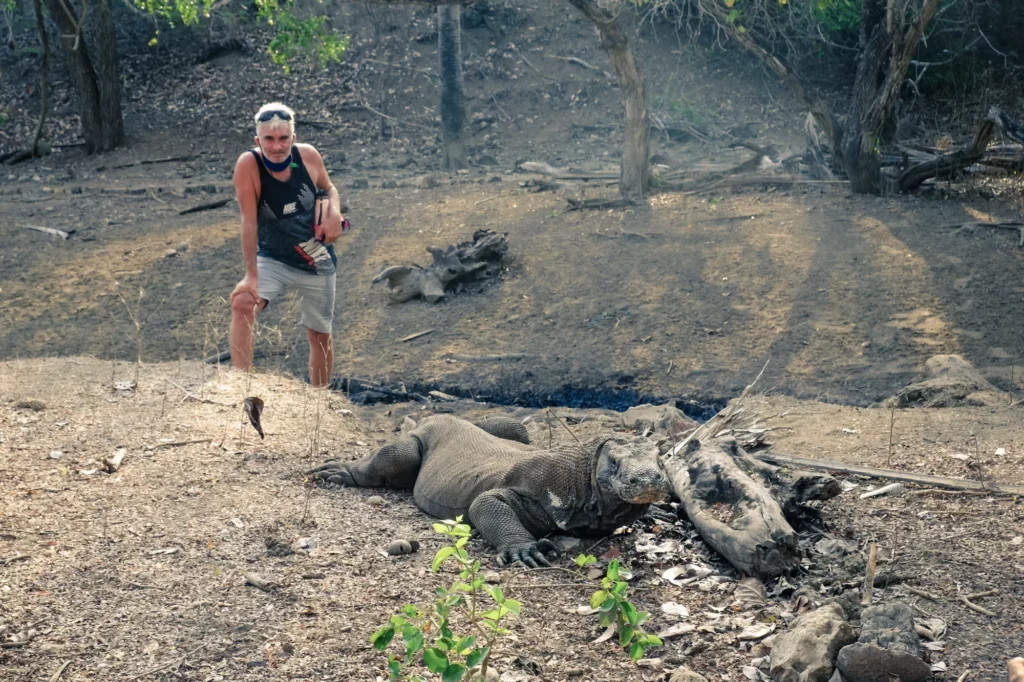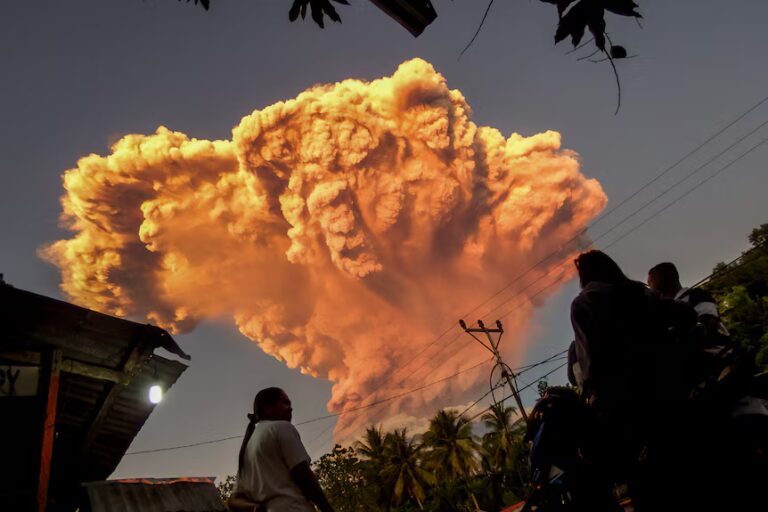If you’ve been to Komodo National Park – or even just scrolled through Instagram – you’ve probably seen it: a massive Komodo dragon lying flat in the sun, eyes half closed, not a care in the world. You might walk right past it, and it won’t even blink. But why is it? Are Komodo Dragons Drugged?
A lot of people ask us the same thing:
“Are they drugged?”
“Is this staged for tourists?”
“Why do they look so out of it?”
It’s a fair question. These are giant carnivorous lizards, after all – you’d expect them to act a bit more… alert. But the truth is, what you’re seeing is completely natural. Let’s break down what’s really happening when a Komodo dragon looks like it’s in a trance – especially after a big meal.
Big Appetite, Bigger Crash
Komodo dragons are apex predators, but they don’t eat often. When they do, though, they go all in. A fully grown Komodo can eat up to 80% of its own body weight in one sitting. That’s like a 70kg person eating 56kg of steak in a single go. After a feast like that, moving around isn’t really on the agenda.
Once they’re full, they’ll drag themselves away from the carcass and collapse somewhere safe and warm. This isn’t laziness or sedation – it’s biology. After eating, almost all their energy is diverted into digestion. Their heart rate drops. Their muscles relax. Their breathing slows. From the outside, it can look like they’re barely alive. But inside, their body is in overdrive – breaking down meat, absorbing nutrients, and keeping themselves alive on this one meal for days or even weeks.

They’re Not Drugged. They’re Cold-Blooded.
One of the biggest misunderstandings we hear is that the dragons must be drugged – because they’re not reacting. But Komodo dragons are ectothermic, meaning they rely on the heat from the sun to regulate their body temperature. They don’t generate their own internal heat like mammals do. So after a meal, they’ll head for a sunny patch and stay there, soaking in warmth to help speed up digestion.
This behavior is called post-prandial thermophily (yep, there’s a word for it), and it’s completely normal for cold-blooded animals. It may look like sunbathing, but it’s really them boosting their internal temperature to keep their digestive system running properly.
Without enough warmth, their digestion slows down dangerously. And if it slows too much, the food inside can begin to rot – which can literally poison them from the inside out. So yeah, lying there like a sun-stoned statue is actually essential for their survival.
Stillness as Strategy
Aside from the physical reasons, there’s a behavioral one too. After eating a huge meal, Komodo dragons become vulnerable. They’re bloated, slower, and not as agile – so instead of patrolling or fighting, they stay hidden or motionless. It’s a survival strategy.
In the wild, they’ll often move into shade, thickets, or leaf piles after basking. If you see one stretched out on a beach trail in the midday heat, it’s likely just finished a big meal and is letting digestion take over.
This is also why they appear so passive when you see them as a visitor – not because they’re sedated, but because they’ve already eaten and their body has shifted into full-on digest mode.

What If They’re Tame? Isn’t That Strange?
Not really. Most of the Komodo dragons seen around ranger stations (like on Komodo Island or Rinca) are semi-habituated to humans. That means they’re used to the presence of people, but they’re still wild animals – and they’re only chill if they’re fed, hot, and resting.
Ask any ranger, though: if a hungry dragon shows up, or if one is startled in the wrong moment, things can change fast. These animals can sprint, climb, and even swim when they need to. What you’re seeing on a slow afternoon isn’t a tame dragon – it’s just one that’s had lunch and is taking it slow.
So… Are They Ever Drugged?
There’s no confirmed evidence of Komodo dragons being sedated in national parks like Komodo or Rinca. Wildlife sedation is illegal and tightly regulated in Indonesia. These animals are managed by rangers, and the guides are trained to keep a safe distance.
That said, skepticism is fair. With tourism growing rapidly and pressure to deliver close-up encounters, it’s good to ask questions. But the scientific explanation behind their post-meal behavior is solid – and the sleepy, spaced-out dragon you see is doing exactly what it’s built to do.
How to See Komodo Dragons Responsibly
If you want to witness Komodo dragons in a respectful and non-intrusive way, we recommend visiting as part of a multi-day liveaboard cruise or a ranger-guided hike.
Try to go early in the morning (before they eat and rest), and travel with ethical operators who understand the park regulations.
You won’t always catch them in action – but when you do, you’ll never forget it.
And when they’re just lying there, basking in the sun like they’ve had a buffet for breakfast? Now you’ll know the truth: they’re not drugged. They’re just full.
Sources & Scientific References
We believe in transparency – here are the sources that informed this blog:
- Auffenberg, W. (1981). The Behavioral Ecology of the Komodo Monitor. University Presses of Florida.
→ The most comprehensive field study on wild Komodo dragon behavior. - Harlow, H. J., Purwandana, D., Jessop, T. S., & Phillips, J. A. (2010). « Body temperature and thermoregulation of Komodo dragons in the field. » Journal of Thermal Biology, 35(7), 338–347. https://doi.org/10.1016/j.jtherbio.2010.07.004
→ Explains how basking is used to regulate body temperature during digestion. - San Diego Zoo Wildlife Alliance – Komodo Dragon Fact Sheet
https://animals.sandiegozoo.org/animals/komodo-dragon
→ Observational data from captive dragons, confirming their long post-feeding rest behavior. - National Geographic – Komodo Dragon Overview
https://www.nationalgeographic.com/animals/reptiles/facts/komodo-dragon
→ Public education resource with insight on metabolism and predatory habits. - Jessop, T. S., et al. (2012). « Demographic and phenotypic effects of human-mediated trophic subsidy on a large Australian lizard. » PLOS ONE, 7(11), e43325. https://doi.org/10.1371/journal.pone.0043325
→ Discusses behavior and energy management in large varanid lizards.
What Would a Drugged Komodo Dragon Look Like?
We had a little fun with AI Image generation tools, and asked it to show us what a drugged Komodo Dragon would look like… Certainly doesn’t look like anything we have seen in the National Park so far… And we’ve never seen them listen to reggae, hip hop or 70’s psychedelic rock.











